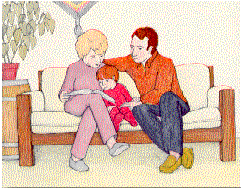
| Anna Grossnickle Hines Home Guide |
|
|

|
|
|
|
Since you are visiting the webpage of a writer of children's books, you probably already know the value of reading to children. Chances are you are already reading to your own children, grandchildren, students, or young library patrons. The problem is reaching those people who don't read to their kids. Most parents really love their children and want to give them every advantage. What parents would not make the effort if they knew that just a few minutes could make such a huge difference? It doesn't even cost anything. And if enough parents and caregivers made that effort, think of the difference it could make in our schools, and eventually in our society. Studies show that today's children start school with a greater store of general knowledge, but seem to lose the advantage by about the 4th grade. At that point they begin having trouble with comprehension, writing clearly, using grammar and problem solving. The New York Times reported that in 1961 the average highschool graduate had a vocabulary of about 25,000 words. A few years ago the average was down to 10,000 words. Children are programmed to learn language from an early age. Pathways that become the basis for future learning are developed at age specific times, but to develop them requires exposure to language. In our fast-paced society most children are getting less one on one interaction with adults. We have fewer dinner table conversations. Reading stories has been replaced by TV and videos. The result is that the bulk of language kids are exposed to is concrete, meaning it is tied to the context and immediate visual and gestural cues. The same is true of TV language. Through listening to stories children build vocabularies and learn to distinguish sounds, rhythms and patterns. The patterns include grammar, sentence structure and story structure, the idea that stories begin, build and come to a conclusion. Through listening to stories children develop listening skills and the ability to focus attention. They develop their ability to visualize, to imagine and think about things not immediately visible. They learn to follow logic and thinking through language, such things as time sequence, and cause and effect. Their ability to organize thoughts grows so they can go on to higher level thinking and problem solving. In addition, reading to a child has great social and emotional benefits, beginning with the bond it establishes between the reader and child. Stories offer reassurance and inspiration. They reinforce values, stimulate curiosity and increase the child's ability to empathize. All this from regular trips to the library and a just few minutes a day! Most of the information above came from Dr. Jane Healy's Endangered Minds, and Jim Trelease's Read Aloud Handbook. |
|
If you have the opportunity to spread the word, please do so. Print this information out and pass it around. If we reach enough people, we can make a difference. See my links to other concerned organizations and programs. Please get involved. If nothing else, read to a child.
|